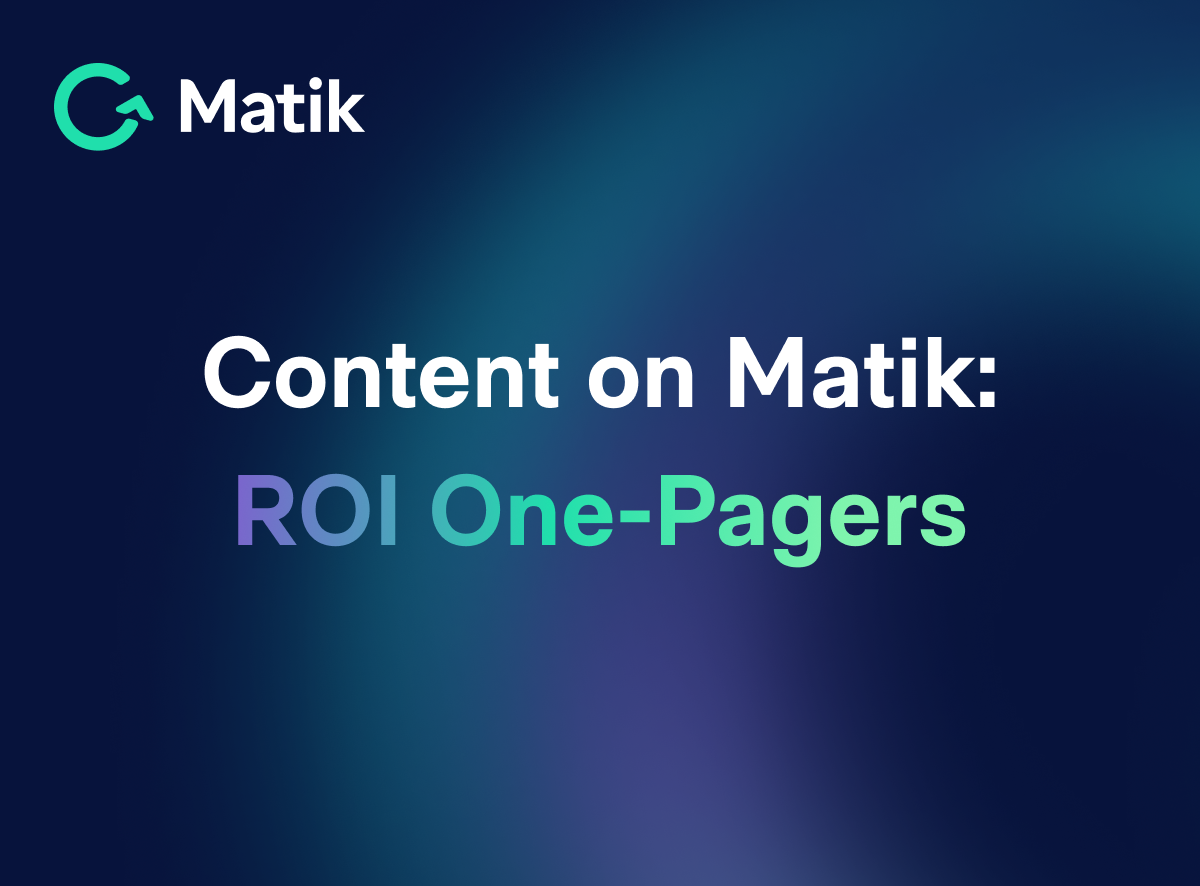Join Our Newsletter
Welcome to the latest post in our Content on Matik series. In this series, we will be taking a look at some of the innovative ways Matik customers have used data-driven storytelling to create compelling content, and build better relationships with their customers.
Meet the ROI One-Pager.
What is an ROI One-Pager?
An ROI One-Pager is a qualitative review of your customer’s pain points and your value props, combined with a quantitative analysis of the ROI, or return on investment, that they will see by purchasing your product.
The most important thing to remember about this type of content is that it needs to be revenue-focused. Whether you’re trying to increase traffic to your customer’s marketing site or to help their sales team save time, you ultimately need to demonstrate how this translates to an overall cost-benefit for your potential new customer.
What is the value of an ROI One-Pager?
When talking to individual contributors or mid-level managers, it makes sense to speak to the specific pains that may have brought these personas to your product.
But when it comes to engaging with decision makers, you need to bring some hard numbers to the table. In other words, how does that time-savings translate to cost savings or revenue generation?
This is where the ROI One-Pager comes in. By tying your product’s value to your customer’s top or bottom line, you can talk to a VP or Finance stakeholder at the level of business that they care about most - revenue.
What is in an ROI One-Pager?
The ROI One-Pager can be a helpful visual aid to a larger conversation around the specific financial value that your potential new customer will see with your product.
Keep in mind that in-depth ROI conversations should only come into play after you’ve already built a business case and demonstrated your value to your customer. Once you’re ready for this conversation, you can share the one-pager as a stand-alone resource or as part of a larger business case or pricing proposal presentation.
This one-pager will be split into several horizontal sections. Start the top of your presentation out with a header, and underneath, share the 2-3 value props of your product that resonate the most with your customer, based on the specific pains they’ve already shared with you that they’re experiencing.
Then, it’s time to dive into the numbers. Create a table that focuses on one or two of your customer’s high-level goals. Let’s use time-savings as an example.
Based on conversations you’ve had with your customer, you should already know how much time they’re spending today on the process you’re looking to help them optimize. Take those number of hours and multiply them by the salary per hour of their team. You can use salary estimates from a tool like Glassdoor, or get this information from your customer directly.
Then, estimate how much time your customer’s team will spend on this process once they purchase your product. Again, multiply these hours spent by the salary per hour for the team, to get an estimate of their time spent with and cost of your more streamlined system.
Subtract the second time number and cost number from the first ones to get the ultimate time and cost savings your customer will see with your product.
Then, take it one step further! Subtract the cost of your product from the total cost savings to get a net cost savings for your customer. Then, divide that cost savings number by the cost of your product to get your final ROI number.
By the end, you should be able to demonstrate to your customer how the cost savings they will see with your product is, for example, 3x the cost that they’ll initially have to put in. Below your table, highlight these three figures (overall time savings, overall cost savings, and your final ROI “X” amount) with visuals to accompany the numbers.
This is just one example of how you can tie your customer’s goal to their company’s bottom line, but there are many, many more ways to show this. Apply this general formula to your own value props and to your customer’s specific needs to kick off an ROI conversation that is data-driven, credible, and tailored to your decision maker's point of view.
In Short
An ROI One-Pager is a qualitative review of your customer’s pain points and your value props, combined with a quantitative analysis of the ROI, or return on investment, that your customer will see by purchasing your product.
---
See Matik in Action—Request a Demo














